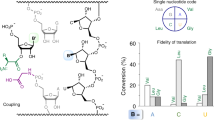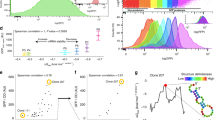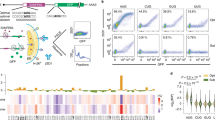Abstract
Base-pairing of messenger RNA to ribosomal RNA is a mechanism of translation initiation in prokaryotes. Although analogous base-pairing has been suggested to affect the translation of various eukaryotic mRNAs, direct evidence has been lacking. To test such base-pairing, we developed a yeast system that uses ribosomes containing a mouse-yeast hybrid 18S rRNA. Using this system, we demonstrate that a 9-nucleotide element found in the mouse Gtx homeodomain mRNA facilitates translation initiation by base-pairing to 18S rRNA. Various point mutations in the Gtx element and in either the hybrid or wild-type yeast 18S rRNAs confirmed the requirement for an intact complementary match. The presence of the Gtx element in various mRNAs suggests that this element affects the translation of groups of mRNAs. We discuss the possibility that other mRNA elements affect translation by base-pairing to different sites in the 18S rRNA.
This is a preview of subscription content, access via your institution
Access options
Subscribe to this journal
Receive 12 print issues and online access
$189.00 per year
only $15.75 per issue
Buy this article
- Purchase on Springer Link
- Instant access to full article PDF
Prices may be subject to local taxes which are calculated during checkout




Similar content being viewed by others
References
Mathews, M.B., Sonenberg, N. & Hershey, J.W. Origins and principles of translational control. in Translational Control of Gene Expression (eds. Sonenberg, N., Hershey, J.W. & Mathews, M.B.) Ch. 1, 1–31 (Cold Spring Harbor Laboratory Press, Cold Spring Harbor, New York, USA, 2000).
Kapp, L.D. & Lorsch, J.R. The molecular mechanics of eukaryotic translation. Annu. Rev. Biochem. 73, 657–704 (2004).
Shine, J. & Dalgarno, L. The 3′-terminal sequence of Escherichia coli 16S ribosomal RNA: complementarity to nonsense triplets and ribosome binding sites. Proc. Natl. Acad. Sci. USA 71, 1342–1346 (1974).
Steitz, J.A. & Jakes, K. How ribosomes select initiator regions in mRNA: base pair formation between the 3′ terminus of 16S rRNA and the mRNA during initiation of protein synthesis in Escherichia coli. Proc. Natl. Acad. Sci. USA 72, 4734–4738 (1975).
Hui, A. & De Boer, H.A. Specialized ribosome system: preferential translation of a single mRNA species by subpopulation of mutated ribosomes in Escherichia coli. Proc. Natl. Acad. Sci. USA 84, 4762–4766 (1987).
Vagner, S., Galy, B. & Pyronnet, S. Irresistible IRES: Attracting the translation machinery to internal ribosome entry sites. EMBO Rep. 2, 893–898 (2001).
Jackson, R.J. A comparative view of initiation site selection mechanisms. in Translational Control of Gene Expression (eds. Sonenberg, N., Hershey, J.W. & Mathews, M.B.) Ch. 4, 127–183 (Cold Spring Harbor Laboratory Press, Cold Spring Harbor, New York, USA, 2000).
Matveeva, O.V. & Shabalina, S.A. Intermolecular mRNA-rRNA hybridization and the distribution of potential interaction regions in murine 18S rRNA. Nucleic Acids Res. 21, 1007–1011 (1993).
Nicholson, R., Pelletier, J., Le, S.-Y. & Sonenberg, N. Structural and functional analysis of the ribosome landing pad of poliovirus type 2: in vivo translation studies. J. Virol. 65, 5886–5894 (1991).
Scheper, G.C., Voorma, H.O. & Thomas, A.A. Base pairing with 18S ribosomal RNA in internal initiation ot translation. FEBS Lett. 352, 271–275 (1994).
Mauro, V.P. & Edelman, G.M. rRNA-like sequences occur in diverse primary transcripts: implications for the control of gene expression. Proc. Natl. Acad. Sci. USA 94, 422–427 (1997).
Tranque, P., Hu, M.C.-Y., Edelman, G.M. & Mauro, V.P. rRNA complementarity within mRNAs: A possible basis for mRNA-ribosome interactions and translational control. Proc. Natl. Acad. Sci. USA 95, 12238–12243 (1998).
Hu, M.C.-Y., Tranque, P., Edelman, G.M. & Mauro, V.P. rRNA-complementarity in the 5′ UTR of mRNA specifying the Gtx homeodomain protein: evidence that base-pairing to 18S rRNA affects translational efficiency. Proc. Natl. Acad. Sci. USA 96, 1339–1344 (1999).
Chappell, S.A., Edelman, G.M. & Mauro, V.P. A 9-nt segment of a cellular mRNA can function as an internal ribosome entry site (IRES) and when present in linked multiple copies greatly enhances IRES activity. Proc. Natl. Acad. Sci. USA 97, 1536–1541 (2000).
Owens, G.C., Chappell, S.A., Mauro, V.P. & Edelman, G.M. Identification of two short internal ribosome entry sites selected from libraries of random oligonucleotides. Proc. Natl. Acad. Sci. USA 98, 1471–1476 (2001).
Mauro, V.P. & Edelman, G.M. The ribosome filter hypothesis. Proc. Natl. Acad. Sci. USA 99, 12031–12036 (2002).
Mignone, F. & Pesole, G. rRNA-like sequences in human mRNAs. Appl. Bioinformatics 1, 145–154 (2002).
Chappell, S.A., Edelman, G.M. & Mauro, V.P. Biochemical and functional analysis of a 9-nucleotide RNA sequence that affects translation efficiency in eukaryotic cells. Proc. Natl. Acad. Sci. USA 101, 9590–9594 (2004).
Chappell, S.A. & Mauro, V.P. The internal ribosome entry site (IRES) contained within the RNA-binding motif protein 3 (Rbm3) mRNA is composed of functionally distinct elements. J. Biol. Chem. 278, 33793–33800 (2003).
Zeenko, V. & Gallie, D.R. Cap-independent translation of tobacco etch virus is conferred by an RNA pseudoknot in the 5′-leader. J. Biol. Chem. 280, 26813–26824 (2005).
Akbergenov, R. et al. ARC-1, a sequence element complementary to an internal 18S rRNA segment, enhances translation efficiency in plants when present in the leader or intercistronic region of mRNAs. Nucleic Acids Res. 32, 239–247 (2004).
Hellen, C.U. & Sarnow, P. Internal ribosome entry sites in eukaryotic mRNA molecules. Genes Dev. 15, 1593–1612 (2001).
Fux, C., Langer, D., Kelm, J.M., Weber, W. & Fussenegger, M. New-generation multicistronic expression platform: pTRIDENT vectors containing size-optimized IRES elements enable homing endonuclease-based cistron swapping into lentiviral expression vectors. Biotechnol. Bioeng. 86, 174–187 (2004).
Reiser, J., Lai, Z., Zhang, X.Y. & Brady, R.O. Development of multigene and regulated lentivirus vectors. J. Virol. 74, 10589–10599 (2000).
Thompson, J., Tapprich, W.E., Munger, C. & Dahlberg, A.E. Staphylococcus aureus domain V functions in Escherichia coli ribosomes provided a conserved interaction with domain IV is restored. RNA 7, 1076–1083 (2001).
Spahn, C.M. et al. Structure of the 80S ribosome from Saccharomyces cerevisiae–tRNA-ribosome and subunit-subunit interactions. Cell 107, 373–386 (2001).
Wai, H.H., Vu, L., Oakes, M. & Nomura, M. Complete deletion of yeast chromosomal rDNA repeats and integration of a new rDNA repeat: use of rDNA deletion strains for functional analysis of rDNA promoter elements in vivo. Nucleic Acids Res. 28, 3524–3534 (2000).
Ausubel, F.M. et al. (eds.) Manipulation of plasmids from yeast cells. in Current Protocols in Molecular Biology Unit 13.9 (Wiley, Hoboken, New Jersey, USA, 2003).
Wimberly, B.T. et al. Structure of the 30S ribosomal subunit. Nature 407, 327–339 (2000).
Yusupova, G.Z., Yusupov, M.M., Cate, J.H. & Noller, H.F. The path of messenger RNA through the ribosome. Cell 106, 233–241 (2001).
Zhou, W., Edelman, G.M. & Mauro, V.P. Isolation and identification of short nucleotide sequences that affect translation initiation in Saccharomyces cerevisiae. Proc. Natl. Acad. Sci. USA 100, 4457–4462 (2003).
Acknowledgements
We thank M. Nomura at the University of California, Irvine, California, USA for providing us with yeast strain NOY908 and plasmids pNOY353 and pNOY373. We also thank L Burman for excellent technical assistance and G.M. Edelman, B.A. Cunningham and J.A. Gally for valuable comments and critical reading of the manuscript. Funding was provided by the US National Institutes of Health (grant GM61725) and the G. Harold and Leila Y. Mathers Charitable Foundation to V.P.M, and by the Skaggs Institute for Chemical Biology to J.D., S.A.C. and W.Z.
Author information
Authors and Affiliations
Corresponding author
Ethics declarations
Competing interests
The authors declare no competing financial interests.
Supplementary information
Supplementary Fig. 1
Expression of hybrid rRNAs in yeast. (PDF 140 kb)
Supplementary Fig. 2
Quantitative northern blot analysis. (PDF 112 kb)
Supplementary Table 1
Expression vectors (PDF 78 kb)
Supplementary Table 2
Yeast strains and plasmids (PDF 89 kb)
Rights and permissions
About this article
Cite this article
Dresios, J., Chappell, S., Zhou, W. et al. An mRNA-rRNA base-pairing mechanism for translation initiation in eukaryotes. Nat Struct Mol Biol 13, 30–34 (2006). https://doi.org/10.1038/nsmb1031
Received:
Accepted:
Published:
Issue Date:
DOI: https://doi.org/10.1038/nsmb1031
This article is cited by
-
IRES-mediated Pichia pastoris cell-free protein synthesis
Bioresources and Bioprocessing (2023)
-
A researcher’s guide to the galaxy of IRESs
Cellular and Molecular Life Sciences (2017)
-
Ribosomal 18S rRNA base pairs with mRNA during eukaryotic translation initiation
Nature Communications (2016)
-
Polyamine stimulation of eEF1A synthesis based on the unusual position of a complementary sequence to 18S rRNA in eEF1A mRNA
Amino Acids (2015)
-
Chloroplast translation regulation
Photosynthesis Research (2007)



